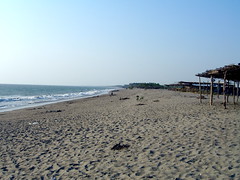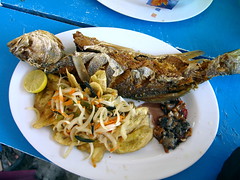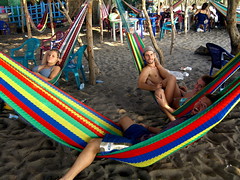Training
On March 13 I took the bus down to my old Field-Based Training site of La Paz, La Paz to spend a couple days working the new crop of health trainees. I went with another Health Volunteer, Tania. She and I are both members of the team that manages the People With HIV (PWH) and Support Groups initiative.
For 8 hours over two days we trained the newbies in the methodologies of the initiative, taught them about the challenges facing PWH in Honduras, and did our best to make them want to work with or start support groups in their communities after they swear in. The training went really well, and I'm really excited to work with some of the new crop of volunteers after they swear in in May.
The Dirty South
After training, I aprovechared the fact that this was the farthest south I had been since swear-in last May, and continued on to the southern part of the country. I took a bus to Tegucigalpa and from there to San Lorenzo, Valle on the Pacific coast of Honduras. There I visited Kyle, another health volunteer from my group.
San Lorenzo is a decent-sized city by Honduran standards, with about the same number of people as Trujillo. But even though it's the same size as Trujillo, it has a lot more economic activity. Most of the roads are paved, there's a real supermarket, and a general sense of stuff happening. It's also ridiculously, oppressively, painfully hot. Thanks to everything being paved, the town just soaks up heat. It's dryer than Trujillo, but still humid enough for the heat to linger well in to the night.
Kyle and I abandoned San Lorenzo the next day to visit Matt in Monjaras. Monjaras is about an hour away, so I got to take in a bit of the countryside of Valle on the way. Valle reminds me of California during that oppressive heat wave we had in 2006, except even hotter. All the hills are bone-dry and brown, the only green coming from some irrigated fields of sugar cane and other crops.
Monjaras is a smaller town, but still pretty well-developed (judging by the internet cafes and paved roads). It was cooler and more shaded than San Lorenzo, a welcome change. From Monjaras we took a short bus trip to Cedeño, a beach town a few kilometers away.
Cedeño was packed (this was the weekend before semana santa, and already people were flocking to the coasts) but we waled a short ways along the beach and the crowds quickly thinned. We found ourselves a table at a beachside restaurant and parked ourselves there for the day.
I had been advised by several honduran friends to try Curiles when I visited the pacific coast, so Matt and I split and order of them with our lunch of fried fish. Curiles are a local mollusk. They have a dark, iron-rich blood. They are served raw in a bowl with their blood, chismol (salsa) and lime juice. That sounds a little gross, but they were delicious! They were tender and very flavorful. I highly recommend them.
Semana Santa
I spent a couple more days with Matt and Kyle in the south. On Tuesday morning, I left Kyle's at 3:45am to catch the first bus to Tegucigalpa. My plan was to take a direct bus from Teguz to La Ceiba, but all those buses were sold out because of the Semana Santa travel rush. So I took a bus from Teguz to San Pedro Sula, then waited for hours before dinally catching a bus from San Pedro Sula to Trujillo. I went from the pacific coast to the atlantic coast overland in one day. I finally arrived home around 10pm, exhausted. 700 kilometers, 18 hours. 30 seconds after arriving, the power went out and stayed out all night.
The next day, I noticed that Trujillo had been completely overwhelmed by tourists. They were everywhere. The beaches and restaurants were packed to the gills. The disco was bumping at 2pm on Wednesday afternoon. I felt like I was living in a different town. I hosted some fellow volunteers over semana santa, and we had fun despite the crowds. By Monday, everyone was gone and my town was back to normal.









4 comments:
My boyfriend Juan has a question about the mollusk ... what are they, we need more details to explain what looks to be a bowl full of blood. More importantly he wants the recipe.
PS We love all the photos !!!
"Curiles are a local mollusk. They have a dark, iron-rich blood."
Do mollusks have blood? If, by chance, they don't, then what kind of blood was in your bowl?
Forgive my ignorance, but I really need more information about mollusk.
As far as I know, the blood belongs to the curiles. I don't know this for a fact, as they were served to me already prepared in the bowl. But a friend of mine from the south says that he has cracked open fresh curiles and they do indeed "bleed" that dark fluid.
the mollusk is a raw black clam, found in the mangroves. The "blood" is an ink similar to that of a squid,they are very delicious and a must try if u are ever in central/south america.
Post a Comment